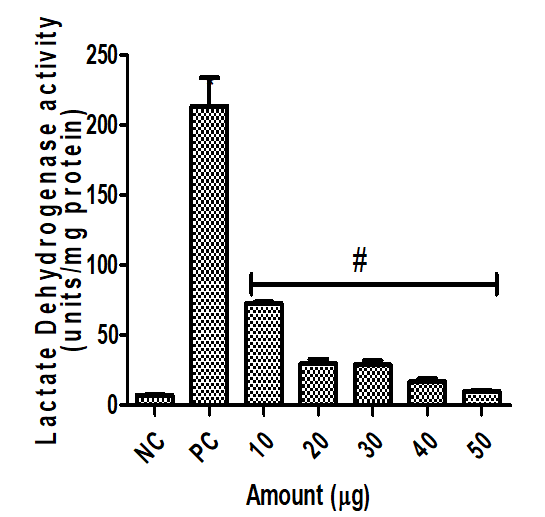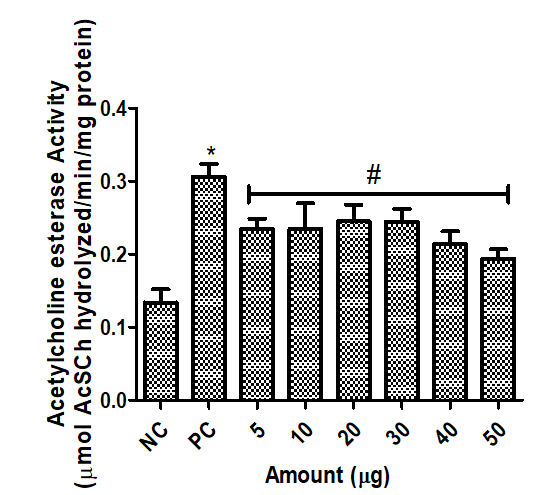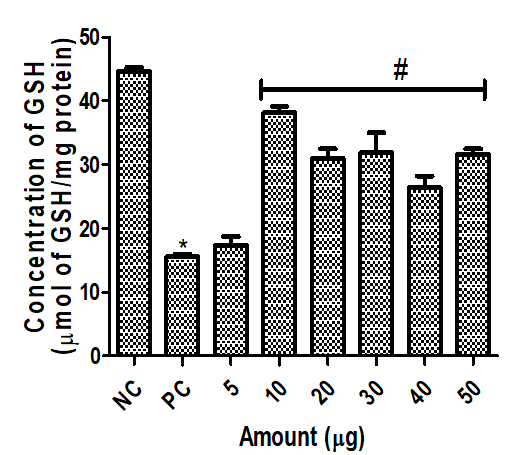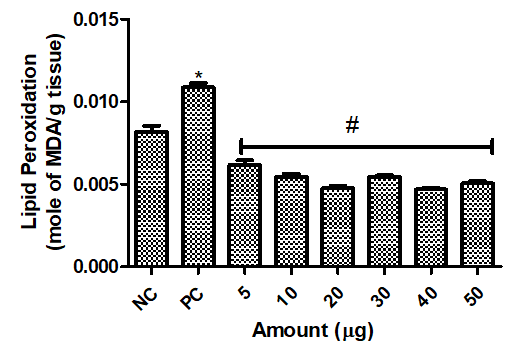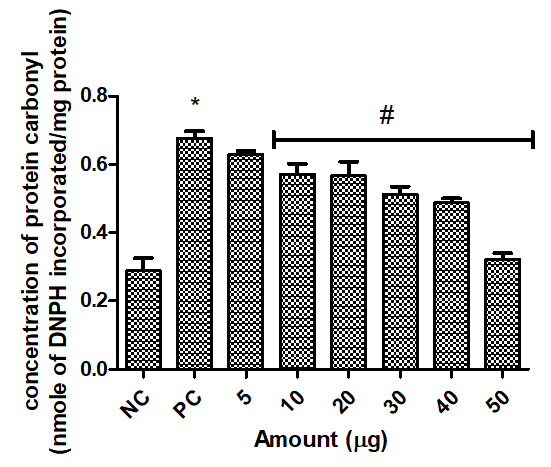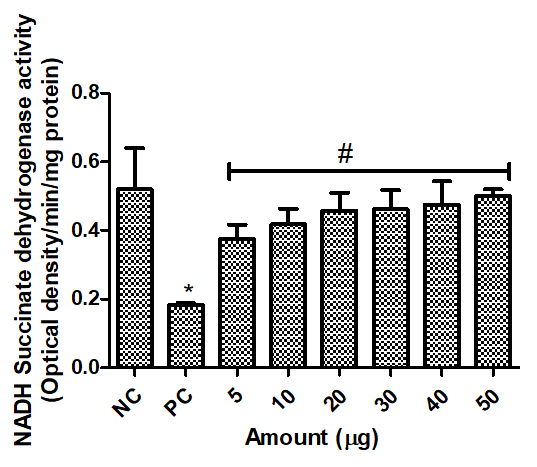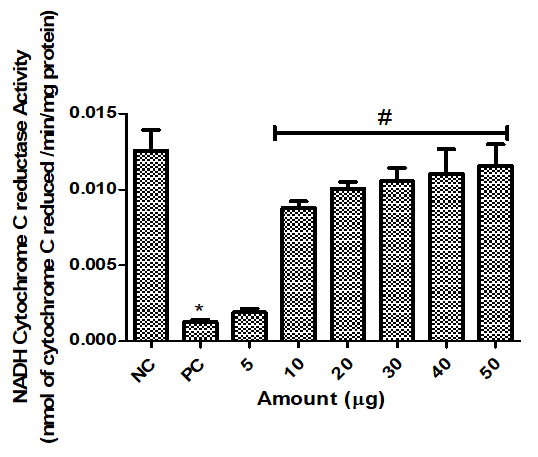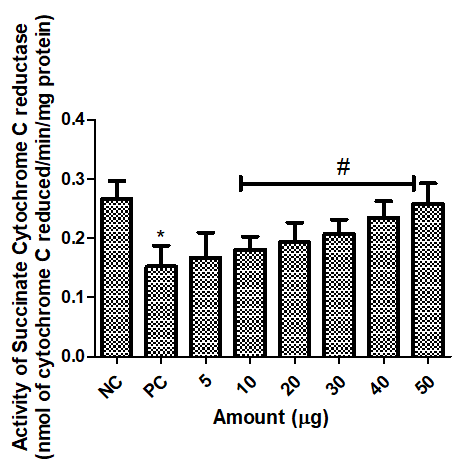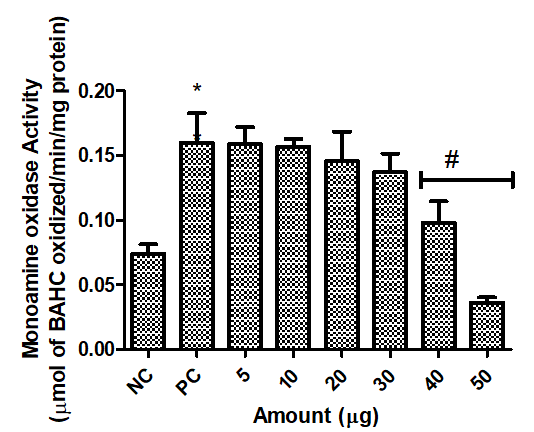1. Smith CJ, Hopmans P, Cook FJ. Accumulation of Cr, Pb, Cu, Ni, Zn and Cd in soil following irrigation with treated urban effluent in Australia. Environmental pollution. 1996;94(3):317-23. [
DOI:10.1016/S0269-7491(96)00089-9] [
PMID]
2. Su P, Zhang J, Wang S, Aschner M, Cao Z, Zhao F, et al. Genistein alleviates lead-induced neurotoxicity in vitro and in vivo: Involvement of multiple signaling pathways. Neurotoxicology. 2016;53:153-64. [
DOI:10.1016/j.neuro.2015.12.019] [
PMID]
3. Gao C, Chang P, Yang L, Wang Y, Zhu S, Shan H. Neuroprotective effects of hydrogen sulfide on sodium azide-induced oxidative stress in PC12 cells. Int J Molecular Med. 2018;41(1):242-50. [
DOI:10.3892/ijmm.2017.3227]
4. Le Blanc-Louvry I, Laburthe-Tolra P, Massol V, Papin F, Goulle JP, Lachatre G, et al. Suicidal sodium azide intoxication: An analytical challenge based on a rare case. Forensic science international. 2012;221(1-3):e17-20. [
DOI:10.1016/j.forsciint.2012.04.006] [
PMID]
5. Ahmad MH, Fatima M, Ali M, Rizvi MA, Mondal AC. Naringenin alleviates paraquat-induced dopaminergic neuronal loss in SH-SY5Y cells and a rat model of Parkinson's disease. Neuropharmacology. 2021;201:108831. [
DOI:10.1016/j.neuropharm.2021.108831] [
PMID]
6. Tefera TW, Steyn FJ, Ngo ST, Borges K. CNS glucose metabolism in Amyotrophic Lateral Sclerosis: a therapeutic target? Cell & bioscience. 2021;11(1):14. [
DOI:10.1186/s13578-020-00511-2] [
PMID] [
PMCID]
7. Ilesanmi OB, Akinmoladun AC, Josiah SS, Olaleye MT, Akindahunsi AA. Modulation of key enzymes linked to Parkinsonism and neurologic disorders by Antiaris africana in rotenone-toxified rats. Journal of basic and clinical physiology and pharmacology. 2019;31(3). [
DOI:10.1515/jbcpp-2019-0014] [
PMID]
8. Liu F, Zou Y, Liu S, Liu J, Wang T. Electro-acupuncture treatment improves neurological function associated with downregulation of PDGF and inhibition of astrogliosis in rats with spinal cord transection. Journal of molecular neuroscience : MN. 2013;51(2):629-35. [
DOI:10.1007/s12031-013-0035-3] [
PMID]
9. Luque-Contreras D, Carvajal K, Toral-Rios D, Franco-Bocanegra D, Campos-Pena V. Oxidative stress and metabolic syndrome: cause or consequence of Alzheimer's disease? Oxidative medicine and cellular longevity. 2014;2014:497802. [
DOI:10.1155/2014/497802] [
PMID] [
PMCID]
10. Marino A, Battaglini M, Moles N, Ciofani G. Natural Antioxidant Compounds as Potential Pharmaceutical Tools against Neurodegenerative Diseases. ACS omega. 2022;7(30):25974-90. [
DOI:10.1021/acsomega.2c03291] [
PMID] [
PMCID]
11. Ahmed MAE, Fahmy HF. Histological study on the effect of sodium azide on the corpus striatum of albino rats and the possible protective role of L-carnitine. Egypt J Histol. 2013;36(1):39-49. [
DOI:10.1097/01.EHX.0000424089.76006.d7]
12. Smith RP, Loius CA, Kruszyna R, Kruszyna H. Acute neurotoxicity of sodium azide and nitric oxide. Fundament Appl Toxicol. 1991;17:120-7. [
DOI:10.1016/0272-0590(91)90244-X] [
PMID]
13. Graham JDP. Actions of sodium azide. British J Pharmacol Chemotherap. 1949;4(1):1.
https://doi.org/10.1111/j.1476-5381.1956.tb01018.x
https://doi.org/10.1111/j.1476-5381.1966.tb01868.x [
DOI:10.1111/j.1476-5381.1949.tb00508.x] [
PMID] [
PMCID]
14. Haas JM, Marsh WM, Jr. Sodium azide: a potential hazard when used to eliminate interferences in the iodometric determination of sulfur. American Industrial Hygiene Association journal. 1970;31(3):318-21. [
DOI:10.1080/0002889708506248] [
PMID]
15. Trout D, Esswein EJ, Hales T, Brown K, Solomon G, Miller M. Exposures and health effects: An evaluation of workers at a sodium azide production plant. America J Indust Med. 1996;30(3):343-50.
https://doi.org/10.1002/(SICI)1097-0274(199609)30:3<343::AID-AJIM13>3.0.CO;2-W [
DOI:10.1002/(SICI)1097-0274(199609)30:33.0.CO;2-W]
16. Klein-Schwartz W, Gorman RL, Oderda GM, Massaro BP, Kurt TL, Garriott JC. Three fatal sodium azide poisonings. Medical toxicology and adverse drug experience. 1989;4(3):219-27. [
DOI:10.1007/BF03259998] [
PMID]
17. Gao C, Chang P, Yang L, Wang Y, Zhu S, Shana H. Neuroprotective effects of hydrogen sulfide on sodium azide-induced oxidative stress in PC12 cells. Intl J Molecular Med. 2018;41:242-50. [
DOI:10.3892/ijmm.2017.3227]
18. Motafeghi F, Mortazavi P, Shahsavari R. Evaluation of the protective role of hydroalcoholic extract of ginger and n-acetylcysteine on genetic disorder caused by sodium azide on human blood lymphocytes by micronucleus method. Stud Med Sci. 2023;34(1):46-57. [
DOI:10.52547/umj.34.1.46]
19. Olajide OJ, Enaibe BU, Bankole OO, Akinola OB, Laoye BJ, Ogundele OM. Kolaviron was protective against sodium azide (NaN3) induced oxidative stress in the prefrontal cortex. Metabolic brain disease. 2016;31(1):25-35. [
DOI:10.1007/s11011-015-9674-0] [
PMID]
20. Ilesanmi OB, Akinmoladun AC, Elusiyan CA, Ogungbe IV, Olugbade TA, Olaleye MT. Neuroprotective flavonoids of the leaf of Antiaris africana Englea against cyanide toxicity. Journal of ethnopharmacology. 2022;282:114592. [
DOI:10.1016/j.jep.2021.114592] [
PMID]
21. Ilesanmi OB, Adewunmi R, Alawode TT, Komolafe KC, Odewale TT, Akinmoladun AC. Alteration of NADH Succinate Dehydrogenase Activity and Redox Status by Different Solvent Fractions of Antiaris Africana in the Brain of Rats Exposed to Rotenone. Biomed J Sci Technic Res. 2019;13(2):1-7. [
DOI:10.26717/BJSTR.2019.13.002371]
22. Ohkawa H, Ohishi N, Yagi K. Assay for lipid peroxides in animal tissues by thiobarbituric acid reaction. Analytical biochemistry. 1979;95(2):351-8. [
DOI:10.1016/0003-2697(79)90738-3] [
PMID]
23. Adam-Vizi V, Seregi A. Receptor independent stimulatory effect of noradrenaline on Na,K-ATPase in rat brain homogenate. Role of lipid peroxidation. Biochemical pharmacology. 1982;31(13):2231-6. [
DOI:10.1016/0006-2952(82)90106-X] [
PMID]
24. Jollow DJ, Mitchell JR, Zampaglione N, Gillette JR. Bromobenzene-induced liver necrosis. Protective role of glutathione and evidence for 3,4-bromobenzene oxide as the hepatotoxic metabolite. Pharmacology. 1974;11(3):151-69. [
DOI:10.1159/000136485] [
PMID]
25. Floor E, Wetzel MG. Increased protein oxidation in human substantia nigra pars compacta in comparison with basal ganglia and prefrontal cortex measured with an improved dinitrophenylhydrazine assay. Journal of neurochemistry. 1998;70(1):268-75. [
DOI:10.1046/j.1471-4159.1998.70010268.x] [
PMID]
26. Ellman GL, Courtney KD, Andres V, Jr., Feather-Stone RM. A new and rapid colorimetric determination of acetylcholinesterase activity. Biochemical pharmacology. 1961;7:88-95. [
DOI:10.1016/0006-2952(61)90145-9] [
PMID]
27. Allen M, Millett P, Dawes E, Rushton N. Lactate dehydrogenase activity as a rapid and sensitive test for the quantification of cell numbers in vitro. Clinical materials. 1994;16(4):189-94. [
DOI:10.1016/0267-6605(94)90116-3] [
PMID]
28. Spinazzi M, Casarin A, Pertegato V, Salviati L, Angelini C. Assessment of mitochondrial respiratory chain enzymatic activities on tissues and cultured cells. Nature protocols. 2012;7(6):1235-46. [
DOI:10.1038/nprot.2012.058] [
PMID]
29. Kollareth DMJ, Muralidhara M. Neuroprotective efficacy of a combination of Fish oil and Ferulic acid against 3-nitropropionic acid-induced oxidative stress and neurotoxicity in rats: behavioral and biochemical evidence. APNM. 2003;39(4):1-10.
30. Holt A, Sharman DF, Baker GB, Palcic MM. A continuous spectrophotometric assay for monoamine oxidase and related enzymes in tissue homogenates. Analytical biochemistry. 1997;244(2):384-92. [
DOI:10.1006/abio.1996.9911] [
PMID]
31. Chaudhary S, Parvez S. An in vitro approach to assess the neurotoxicity of valproic acid-induced oxidative stress in cerebellum and cerebral cortex of young rats. Neuroscience. 2012;225:258-68. [
DOI:10.1016/j.neuroscience.2012.08.060] [
PMID]
32. Zhang RY, Zhang X, Zhang L, Wu YC, Sun XJ, Li L. Tetrahydroxystilbene glucoside protects against sodium azide-induced mitochondrial dysfunction in human neuroblastoma cells. Chinese herbal medicines. 2021;13(2):255-60. [
DOI:10.1016/j.chmed.2020.11.007] [
PMID] [
PMCID]
33. Zhang Y, Huang N, Lu H, Huang J, Jin H, Shi J, et al. Icariin protects against sodium azide-induced neurotoxicity by activating the PI3K/Akt/GSK-3beta signaling pathway. PeerJ. 2020;8:e8955. [
DOI:10.7717/peerj.8955] [
PMID] [
PMCID]
34. Mahdi O, Baharuldin MTH, Nor NHM, Chiroma SM, Jagadeesan S, Moklas MAM. Chemicals used for the induction of Alzheimer's disease-like cognitive dysfunctions in rodents. Biomed Res Ther. 2019;6(11):3460-84. [
DOI:10.15419/bmrat.v6i11.575]
35. Suzuki Y, Taguchi K, Hanyu S, Kure T, Enoki Y, Otagiri M. Oxidized liposomal artificial red blood cells rescue azide-poisoned mice from lethal toxidrome by recovering cytochrome c oxidase activity. J Drug Delivery Sci Technol. 2022;71:103282. [
DOI:10.1016/j.jddst.2022.103282]
36. Liu X, Wei Q, Yang X, Wang X, Zhang J, Xu R, et al. Lipidomics Reveals Dysregulated Glycerophospholipid Metabolism in the Corpus Striatum of Mice Treated with Cefepime. ACS chemical neuroscience. 2021;12(23):4449-64. [
DOI:10.1021/acschemneuro.1c00608] [
PMID]
37. Alamro AA, Alsulami EA, Almutlaq M, Alghamedi A, Alokail M, Haq SH. Therapeutic Potential of Vitamin D and Curcumin in an In Vitro Model of Alzheimer Disease. Journal of central nervous system disease. 2020;12:1179573520924311. [
DOI:10.1177/1179573520924311] [
PMID] [
PMCID]
38. Olajide OJ, Asogwa NT, Moses BO, Oyegbola CB. Multidirectional inhibition of cortico-hippocampal neurodegeneration by kolaviron treatment in rats. Metabolic brain disease. 2017;32(4):1147-61. [
DOI:10.1007/s11011-017-0012-6] [
PMID]
39. Jayasena T, Poljak A, Braidy N, Smythe G, Raftery M, Hill M, et al. Upregulation of glycolytic enzymes, mitochondrial dysfunction and increased cytotoxicity in glial cells treated with Alzheimer's disease plasma. PloS one. 2015;10(3):e0116092. [
DOI:10.1371/journal.pone.0116092] [
PMID] [
PMCID]
40. Walczak-Nowicka LJ, Herbet M. Acetylcholinesterase Inhibitors in the Treatment of Neurodegenerative Diseases and the Role of Acetylcholinesterase in their Pathogenesis. International journal of molecular sciences. 2021;22(17). [
DOI:10.3390/ijms22179290] [
PMID] [
PMCID]
41. Utkin YN. Aging Affects Nicotinic Acetylcholine Receptors in Brain. Central nervous system agents in medicinal chemistry. 2019;19(2):119-24. [
DOI:10.2174/1871524919666190320102834] [
PMID]
42. Akinrinde AS, Fapuro J, Soetan KO. Zinc and ascorbic acid treatment alleviates systemic inflammation and gastrointestinal and renal oxidative stress induced by sodium azide in rats. Beni Suef Univ J Basic Appl Sci. 2021;10(1):1-11. [
DOI:10.1186/s43088-021-00108-9]
43. Moustapha A. Neurodegenerative diseases: potential effect of glutathione. In Glutathione System and Oxidative Stress in Health and Disease. Intech Open. 2020. [
DOI:10.5772/intechopen.92240]
44. Christopher Kwon YI, Xie W, Zhu H, Xie J, Shinn K, Juckel N, et al. gamma-Glutamyl-Transpeptidase-Resistant Glutathione Analog Attenuates Progression of Alzheimer's Disease-like Pathology and Neurodegeneration in a Mouse Model. Antioxidants. 2021;10(11). [
DOI:10.3390/antiox10111796] [
PMID] [
PMCID]
45. Lizzo G, Migliavacca E, Lamers D, Frezal A, Corthesy J, Vinyes-Pares G, et al. A Randomized Controlled Clinical Trial in Healthy Older Adults to Determine Efficacy of Glycine and N-Acetylcysteine Supplementation on Glutathione Redox Status and Oxidative Damage. Frontiers in aging. 2022;3:852569. [
DOI:10.3389/fragi.2022.852569] [
PMID] [
PMCID]
46. Guloyan V, Oganesian B, Baghdasaryan N, Yeh C, Singh M, Guilford F, et al. Glutathione Supplementation as an Adjunctive Therapy in COVID-19. Antioxidants. 2020;9(10). [
DOI:10.3390/antiox9100914] [
PMID] [
PMCID]
47. Lekchand Dasriya V, Samtiya M, Dhewa T, Puniya M, Kumar S, Ranveer S, et al. Etiology and management of Alzheimer's disease: Potential role of gut microbiota modulation with probiotics supplementation. Journal of food biochemistry. 2022;46(1):e14043. [
DOI:10.1111/jfbc.14043] [
PMID]
48. Rodriguez-Garcia A, Garcia-Vicente R, Morales ML, Ortiz-Ruiz A, Martinez-Lopez J, Linares M. Protein Carbonylation and Lipid Peroxidation in Hematological Malignancies. Antioxidants. 2020;9(12). [
DOI:10.3390/antiox9121212] [
PMID] [
PMCID]
49. Kolar D, Kleteckova L, Skalova K, Brozka H, Kalous M, Vales K. Glycolytic and Krebs cycle enzymes activity in rat prefrontal cortex, hippocampus, and striatum after single and repeated NMDA inhibition by MK-801. Neurotoxicology. 2022;90:35-47. [
DOI:10.1016/j.neuro.2022.02.005] [
PMID]
50. Cho SG, Du Q, Huang S, Dong Z. Drp1 dephosphorylation in ATP depletion-induced mitochondrial injury and tubular cell apoptosis. American journal of physiology Renal physiology. 2010;299(1):F199-206. [
DOI:10.1152/ajprenal.00716.2009] [
PMID] [
PMCID]
51. Chen LW, Wang YQ, Wei LC, Shi M, Chan YS. Chinese herbs and herbal extracts for neuroprotection of dopaminergic neurons and potential therapeutic treatment of Parkinson's disease. CNS & neurological disorders drug targets. 2007;6(4):273-81. [
DOI:10.2174/187152707781387288] [
PMID]
52. Mathang DC, Namasivayam A. Effect of chronic sublethal cyanide administration on brain neurotransmitters and behaviour in rats. J Occup Health. 2000;42:88-90. [
DOI:10.1539/joh.42.88]
53. Adewunmi R, Ilesanmi OB, Crown OO, Komolafe KC, Akinmoladun AC, Olaleye TM. Attenuation of KCN-induced Neurotoxicity by Solvent Fractions of Antiarisafricana Leaf. Europe J Med Plant. 2018;23(2):1-11. [
DOI:10.9734/EJMP/2018/41054]
54. Kuete V, Vouffo B, Mbaveng AT, Vouffo EY, Siagat RM, Dongo E. Evaluation of Antiaris africana methanol extract and compounds for antioxidant and antitumor activities. Pharmaceut Biol. 2009;47(11):1042-9. [
DOI:10.3109/13880200902988595]
55. Filippov MA, Tatarnikova OG, Pozdnyakova NV, Vorobyov VV. Inflammation/bioenergetics-associated neurodegenerative pathologies and concomitant diseases: a role of mitochondria targeted catalase and xanthophylls. Neural regeneration research. 2021;16(2):223-33. [
DOI:10.4103/1673-5374.290878] [
PMID] [
PMCID]
56. Min HY, Pei H, Hyun SY, Boo HJ, Jang HJ, Cho J, et al. Potent Anticancer Effect of the Natural Steroidal Saponin Gracillin Is Produced by Inhibiting Glycolysis and Oxidative Phosphorylation-Mediated Bioenergetics. Cancers. 2020;12(4). [
DOI:10.3390/cancers12040913] [
PMID] [
PMCID]








































